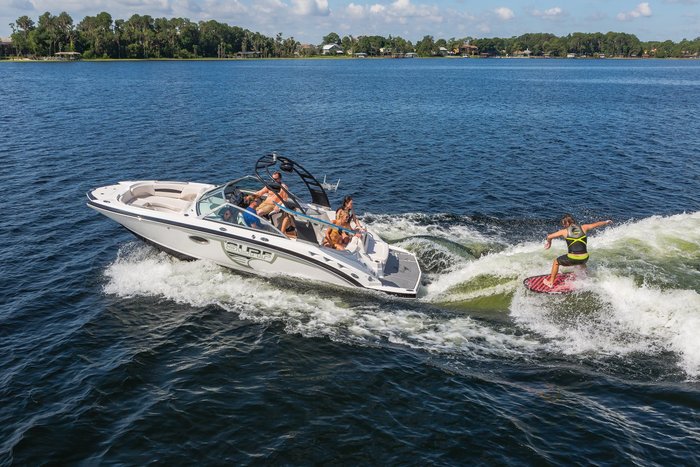Wakesurfing 101: How to Be a Successful Spotter

We hear a lot about wakesurfing from a behind-the-boat perspective—how to move, flip, turn and twist to achieve the ultimate ride. But did you know that half of the action happens on board?
We have captains to thank for producing the perfect wake for a smooth, enjoyable ride—and spotters for keeping us safe all the way there.
If you find yourself serving as a spotter on family wakesurfing adventures this summer, your role is more important than you might think. Read on as we share a few simple tips for being a successful spotter, and having some fun along the way.
Know your role
As a good spotter, it naturally helps to know your role. When you head out for a family boat day, and you find yourself delegated to that spot on the stern, you may be wondering what’s expected of you—beyond, perhaps, waiting until it’s your turn to ride.
There are a few key duties of a spotter—the first, of course, is to spot or observe, the surfer being towed. You should keep your eye on them in case they need a hand, or want to go faster, slower, etc.—we’ll get to the lingo next! Of course, it’s not hard to do that. Whether it’s a friend or family member, watching someone you care about enjoy the water (especially if they’re just starting out) is a real treat, and their time on the water is sure to be the subject of lots of talk, and maybe some laughs, later on.
Another role of the spotter, specific to the sport of wakesurfing, is collecting the rope after it’s been tossed into the water or back toward the stern. With wakeboarding or waterskiing, the rider holds onto the rope the whole way through—but in this case, they’re done with it once they get up on their feet. You, as the spotter, can either catch the rope or help pull it in (for young or new riders, it’s usually recommended to simply let go of the rope instead of throwing it, so they don’t go off balance).
Learn the lingo
If you’ve been on the other end of the tow rope for wakeboarding or waterskiing, you probably already have the basic hand signals down. If not, it is definitely helpful to learn them now, since the rider will use them to communicate what he or she needs while out on the water—and you, in turn, can get the message to the captain.
Basic signals include…
- Thumb up: Speed up
- Thumb down: Slow down
- Line across neck motion: Stop
- A-ok symbol: Good speed/motion
- Right/left hand motion: Turn right/left
- Hands holding each other over head: I’m okay! (after fall)
Since it can be loud on the water, also suggest words and phrases that can’t be in the noise—instead of “go” for “let’s get going,” for example, try “hit it,” “crank it,” etc.
Enjoy the ride
How could you not enjoy the ride as a spotter? The breeze, the spray, the thrill of watching your favorite water sport in action—and thinking of ways to perfect your own flips and spins on your next turn.
As a spotter, you can kick back by the stern—and maybe even play some tunes from the transom—while you enjoy the view. Also worth noting: wakesurfing is not a spectator sport! Even if you’re not on the water just yet, you can still take part in the fun by cheering for your friend on their board or offering tricks for them to try. Make some noise and have fun with it.
We hope that these tips help you get even more out of your wakesurfing adventures this summer. Now get out there and do your thing—even if you’re secretly counting down the minutes until your turn to board all the while!
Bookmark & Share
Previous Article
